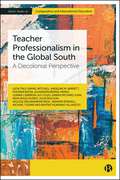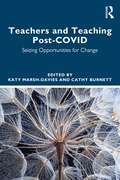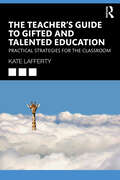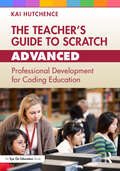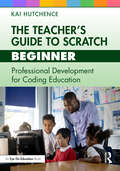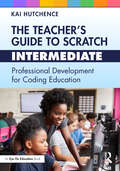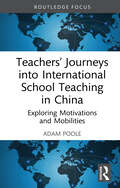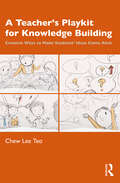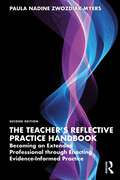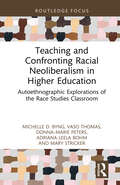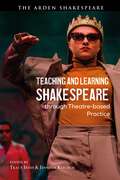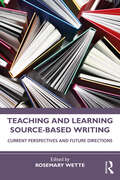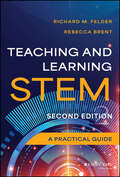- Table View
- List View
Teacher Professionalism in the Global South: A Decolonial Perspective (Bristol Studies in Comparative and International Education)
by Leon Tikly Rafael Mitchell Angeline M. Barrett Poonam Batra Alexandra Bernal Leanne Cameron Alf Coles Zawadi Richard Juma Nidia Aviles Nunez Julia Paulson Nigusse Weldemariam Reda Jennifer Rowsell Michael Tusiime Beatriz VejaranoThis book provides a decolonial critique of dominant global agendas concerning teacher professionalism and proposes a new understanding based on UNESCO-funded research with teachers based in Colombia, Ethiopia (Tigray), India, Rwanda and Tanzania. Outlining from a teacher’s perspective how teacher professionalism may be conceptualized, this book critiques dominant global narratives and conceptions based on deficit discourses. The authors argue that a decolonial lens can help to contextualize the perspectives, experiences and material conditions of teachers in the global South, and the value of such a framework for informing global debates and decision-making in education.
Teacher Professionalism in the Global South: A Decolonial Perspective (Bristol Studies in Comparative and International Education)
by Leon Tikly Rafael Mitchell Angeline M. Barrett Poonam Batra Alexandra Bernal Leanne Cameron Alf Coles Zawadi Richard Juma Nidia Aviles Nunez Julia Paulson Nigusse Weldemariam Reda Jennifer Rowsell Michael Tusiime Beatriz VejaranoThis book provides a decolonial critique of dominant global agendas concerning teacher professionalism and proposes a new understanding based on UNESCO-funded research with teachers based in Colombia, Ethiopia (Tigray), India, Rwanda and Tanzania. Outlining from a teacher’s perspective how teacher professionalism may be conceptualized, this book critiques dominant global narratives and conceptions based on deficit discourses. The authors argue that a decolonial lens can help to contextualize the perspectives, experiences and material conditions of teachers in the global South, and the value of such a framework for informing global debates and decision-making in education.
Teachers and Teaching Post-COVID: Seizing Opportunities for Change
by Katy Marsh-Davies Cathy BurnettFeaturing a broad swathe of academic research and perspectives from international contributors, this book will capture and share important lessons from the pandemic experience for teaching practice and teacher learning more broadly. Looking at core teaching values such as the facilitation of learning, the promotion of fairness and equality, and community building, the book centres the records of teachers’ experiences from diverse educational phases and locations that illuminate how the complexity of teaching work is entangled in the emotional, relational, and embodied nature of teachers’ everyday lives. Through rich, qualitative data and first-hand experience, the book informs the decisions of teachers and those who train, support, and manage them, promoting sustainable, positive transformation within education for the benefit of educators and learners alike. This book will be of use to scholars, practitioners, and researchers involved with teachers and teacher education, the sociology of education, and teaching and learning more broadly. Policy makers working in school leadership, management, and administration may also benefit from the volume.
Teachers and Teaching Post-COVID: Seizing Opportunities for Change
Featuring a broad swathe of academic research and perspectives from international contributors, this book will capture and share important lessons from the pandemic experience for teaching practice and teacher learning more broadly. Looking at core teaching values such as the facilitation of learning, the promotion of fairness and equality, and community building, the book centres the records of teachers’ experiences from diverse educational phases and locations that illuminate how the complexity of teaching work is entangled in the emotional, relational, and embodied nature of teachers’ everyday lives. Through rich, qualitative data and first-hand experience, the book informs the decisions of teachers and those who train, support, and manage them, promoting sustainable, positive transformation within education for the benefit of educators and learners alike. This book will be of use to scholars, practitioners, and researchers involved with teachers and teacher education, the sociology of education, and teaching and learning more broadly. Policy makers working in school leadership, management, and administration may also benefit from the volume.
The Teacher’s Guide to Gifted and Talented Education: Practical Strategies for the Classroom
by Kate LaffertyThe Teacher’s Guide to Gifted and Talented Education: Practical strategies for the Classroom demonstrates ways to build and enhance your understanding of gifted learners with evidence-based, hands-on strategies to use in the classroom. Whether you are looking to improve your own practice or starting out as a Gifted Education coordinator in your school, this book will guide you through each step. Written by an author with extensive practical and research experience in the field, the book is informed by research and covers essential topics from theoretical frameworks to differentiation and innovative pedagogies. Each chapter includes a ‘Back to basics’ section, which provides the key information for those wanting just enough to get going, a ‘Taking it further’ section, which offers a more in-depth critique of the content and a ‘Chapter reflection’ which provides an opportunity to plan and set goals. This book offers a way of thinking about developing the talents of students, at all year levels, in all learning domains and in all contexts. It provides approaches that can be applied in the classroom immediately, or spark bigger conversations within the school. Filled with tips, strategies, checklists and templates, The Teacher’s Guide to Gifted and Talented Education is an essential resource for all educators, from early childhood through to secondary school.
The Teacher’s Guide to Gifted and Talented Education: Practical Strategies for the Classroom
by Kate LaffertyThe Teacher’s Guide to Gifted and Talented Education: Practical strategies for the Classroom demonstrates ways to build and enhance your understanding of gifted learners with evidence-based, hands-on strategies to use in the classroom. Whether you are looking to improve your own practice or starting out as a Gifted Education coordinator in your school, this book will guide you through each step. Written by an author with extensive practical and research experience in the field, the book is informed by research and covers essential topics from theoretical frameworks to differentiation and innovative pedagogies. Each chapter includes a ‘Back to basics’ section, which provides the key information for those wanting just enough to get going, a ‘Taking it further’ section, which offers a more in-depth critique of the content and a ‘Chapter reflection’ which provides an opportunity to plan and set goals. This book offers a way of thinking about developing the talents of students, at all year levels, in all learning domains and in all contexts. It provides approaches that can be applied in the classroom immediately, or spark bigger conversations within the school. Filled with tips, strategies, checklists and templates, The Teacher’s Guide to Gifted and Talented Education is an essential resource for all educators, from early childhood through to secondary school.
The Teacher’s Guide to Scratch – Advanced: Professional Development for Coding Education
by Kai HutchenceThe Teacher’s Guide to Scratch – Advanced is a practical guide for educators preparing sophisticated coding lessons and assignments in their K–12 classrooms. The world’s largest and most active visual programming platform, Scratch helps today’s schools answer the growing call to realize important learning outcomes using coding and computer science. This book illustrates the expert-level potential of Scratch coding, details effective pedagogical strategies and learner collaborations, and offers actionable, accessible troubleshooting tips. Geared toward the advanced user, these four unique coding projects will provide the technical training that teachers need to master Scratch, feeling comfortable and confident in their skills as they unlock the program’s full potential for themselves and their students. Clear goals, a comprehensive glossary, and other features ensure the project’s enduring relevance as a reference work for computer science education in grade school. Thanks to Scratch’s cost-effective open-source license, suitability for blended and project-based learning, notable lack of privacy or security risks, and consistency in format even amid software and interface updates, this will be an enduring practitioner manual and professional development resource for years to come.
The Teacher’s Guide to Scratch – Advanced: Professional Development for Coding Education
by Kai HutchenceThe Teacher’s Guide to Scratch – Advanced is a practical guide for educators preparing sophisticated coding lessons and assignments in their K–12 classrooms. The world’s largest and most active visual programming platform, Scratch helps today’s schools answer the growing call to realize important learning outcomes using coding and computer science. This book illustrates the expert-level potential of Scratch coding, details effective pedagogical strategies and learner collaborations, and offers actionable, accessible troubleshooting tips. Geared toward the advanced user, these four unique coding projects will provide the technical training that teachers need to master Scratch, feeling comfortable and confident in their skills as they unlock the program’s full potential for themselves and their students. Clear goals, a comprehensive glossary, and other features ensure the project’s enduring relevance as a reference work for computer science education in grade school. Thanks to Scratch’s cost-effective open-source license, suitability for blended and project-based learning, notable lack of privacy or security risks, and consistency in format even amid software and interface updates, this will be an enduring practitioner manual and professional development resource for years to come.
The Teacher’s Guide to Scratch – Beginner: Professional Development for Coding Education
by Kai HutchenceThe Teacher’s Guide to Scratch – Beginner is a practical guide for educators preparing beginners-level coding lessons and assignments in their K–12 classrooms. The world’s largest and most active visual programming platform, Scratch helps today’s schools answer the growing call to realize important learning outcomes using coding and computer science. This book illustrates the benefits and fundamental building blocks of Scratch coding, details effective pedagogical strategies and learner collaborations, and offers actionable, accessible troubleshooting tips. Geared toward the fledgling user, these four unique coding projects will provide the technical training that teachers need to feel comfortable and confident in their skills and to help instill the same feeling of accomplishment in their students. Clear goals, a comprehensive glossary, and other features ensure the project’s enduring relevance as a reference work for computer science education in grade school. Thanks to Scratch’s cost-effective open-source license, suitability for blended and project-based learning, notable lack of privacy or security risks, and consistency in format even amid software and interface updates, this will be an enduring practitioner manual and professional development resource for years to come.
The Teacher’s Guide to Scratch – Beginner: Professional Development for Coding Education
by Kai HutchenceThe Teacher’s Guide to Scratch – Beginner is a practical guide for educators preparing beginners-level coding lessons and assignments in their K–12 classrooms. The world’s largest and most active visual programming platform, Scratch helps today’s schools answer the growing call to realize important learning outcomes using coding and computer science. This book illustrates the benefits and fundamental building blocks of Scratch coding, details effective pedagogical strategies and learner collaborations, and offers actionable, accessible troubleshooting tips. Geared toward the fledgling user, these four unique coding projects will provide the technical training that teachers need to feel comfortable and confident in their skills and to help instill the same feeling of accomplishment in their students. Clear goals, a comprehensive glossary, and other features ensure the project’s enduring relevance as a reference work for computer science education in grade school. Thanks to Scratch’s cost-effective open-source license, suitability for blended and project-based learning, notable lack of privacy or security risks, and consistency in format even amid software and interface updates, this will be an enduring practitioner manual and professional development resource for years to come.
The Teacher’s Guide to Scratch – Intermediate: Professional Development for Coding Education
by Kai HutchenceThe Teacher’s Guide to Scratch – Intermediate is a practical guide for educators preparing moderately complex coding lessons and assignments in their K-12 classrooms. The world’s largest and most active visual programming platform, Scratch helps today’s schools answer the growing call to realize important learning outcomes using coding and computer science. This book illustrates the increasingly intricate affordances of Scratch coding, details effective pedagogical strategies and learner collaborations, and offers actionable, accessible troubleshooting tips. Geared toward the intermediate user, these four unique coding projects will provide the technical training that teachers need to feel comfortable and confident in their skills and to help instill the same feeling of accomplishment in their students. Clear goals, a comprehensive glossary, and other features ensure the project’s enduring relevance as a reference work for computer science education in grade school. Thanks to Scratch’s cost-effective open-source license, suitability for blended and project-based learning, notable lack of privacy or security risks, and consistency in format even amid software and interface updates, this will be an enduring practitioner manual and professional development resource for years to come.
The Teacher’s Guide to Scratch – Intermediate: Professional Development for Coding Education
by Kai HutchenceThe Teacher’s Guide to Scratch – Intermediate is a practical guide for educators preparing moderately complex coding lessons and assignments in their K-12 classrooms. The world’s largest and most active visual programming platform, Scratch helps today’s schools answer the growing call to realize important learning outcomes using coding and computer science. This book illustrates the increasingly intricate affordances of Scratch coding, details effective pedagogical strategies and learner collaborations, and offers actionable, accessible troubleshooting tips. Geared toward the intermediate user, these four unique coding projects will provide the technical training that teachers need to feel comfortable and confident in their skills and to help instill the same feeling of accomplishment in their students. Clear goals, a comprehensive glossary, and other features ensure the project’s enduring relevance as a reference work for computer science education in grade school. Thanks to Scratch’s cost-effective open-source license, suitability for blended and project-based learning, notable lack of privacy or security risks, and consistency in format even amid software and interface updates, this will be an enduring practitioner manual and professional development resource for years to come.
Teachers’ Journeys into International School Teaching in China: Exploring Motivations and Mobilities (Routledge Series on Schools and Schooling in Asia)
by Adam PoolePoole’s book illuminates the experiences and perspectives of host country national teachers at internationalised schools in China. The international school sector in China has undergone significant changes in recent years. This is due to the growing demand for international education from local middle-class families. In response, a new type of school has emerged. Going by various names, such as private, bilingual or internationalised, these schools offer a fusion of national and international curricula and are staffed predominantly by host country national teachers. Despite these changes, we still know little about who host country national teachers are and what draws them to the world of international schooling. Accordingly, this book explores the motivations and mobilities of host country national teachers in China. It identifies three types of teacher: Returners, Reachers, and Remainers. Returners are graduates who have returned to China from overseas study. They are drawn to international schools by the opportunity to use their international experience and qualification. Reachers are internal migrants who face structural inequality and attracted to international schools by the opportunity for social mobility. Remainers are married teachers with children. They are motivated to work in international schools by the perceived stability and security these schools offer. Discussing implications for teacher recruitment, development, and retention in international schools, this book is an essential read for international educational researchers as well as students researching international education or teacher identity.
Teachers’ Journeys into International School Teaching in China: Exploring Motivations and Mobilities (Routledge Series on Schools and Schooling in Asia)
by Adam PoolePoole’s book illuminates the experiences and perspectives of host country national teachers at internationalised schools in China. The international school sector in China has undergone significant changes in recent years. This is due to the growing demand for international education from local middle-class families. In response, a new type of school has emerged. Going by various names, such as private, bilingual or internationalised, these schools offer a fusion of national and international curricula and are staffed predominantly by host country national teachers. Despite these changes, we still know little about who host country national teachers are and what draws them to the world of international schooling. Accordingly, this book explores the motivations and mobilities of host country national teachers in China. It identifies three types of teacher: Returners, Reachers, and Remainers. Returners are graduates who have returned to China from overseas study. They are drawn to international schools by the opportunity to use their international experience and qualification. Reachers are internal migrants who face structural inequality and attracted to international schools by the opportunity for social mobility. Remainers are married teachers with children. They are motivated to work in international schools by the perceived stability and security these schools offer. Discussing implications for teacher recruitment, development, and retention in international schools, this book is an essential read for international educational researchers as well as students researching international education or teacher identity.
A Teacher’s Playkit for Knowledge Building: Creative Ways to Make Students’ Ideas Come Alive
by Chew Lee TeoDelving into the journey of teachers and students in the knowledge building classroom, Teo’s playkit offers practical approaches to making classrooms a place of knowledge creation.Teo highlights the potential and possibility of idea-centric discourse and interactions in Singapore’s high-performing education system while offering a trilogue among researchers, teachers and students: the agents of a knowledge building environment in classrooms. Documenting case examples of knowledge building lessons in relation to the curriculum design and pedagogical decisions and moves, as well as the formative assessment, the book focuses on those 21st-century practices embedded within the knowledge building process. It comprises a series of teachers’ journeys in different subjects and grades, demonstrating the depth and breadth of projects that students are capable of pursuing in class when they are entrusted to work with their own ideas and questions. It also offers a collection of concrete tools and strategies for teachers to use to support knowledge building work. The different case examples support teachers in their design effort and will encourage the community of researchers and educators to continue to imagine the possibilities of pedagogical educational reform.Written for practitioners, this playkit aims to engage the wider community of teachers to play with their own lesson ideas as they engage their students in knowledge creation.
A Teacher’s Playkit for Knowledge Building: Creative Ways to Make Students’ Ideas Come Alive
by Chew Lee TeoDelving into the journey of teachers and students in the knowledge building classroom, Teo’s playkit offers practical approaches to making classrooms a place of knowledge creation.Teo highlights the potential and possibility of idea-centric discourse and interactions in Singapore’s high-performing education system while offering a trilogue among researchers, teachers and students: the agents of a knowledge building environment in classrooms. Documenting case examples of knowledge building lessons in relation to the curriculum design and pedagogical decisions and moves, as well as the formative assessment, the book focuses on those 21st-century practices embedded within the knowledge building process. It comprises a series of teachers’ journeys in different subjects and grades, demonstrating the depth and breadth of projects that students are capable of pursuing in class when they are entrusted to work with their own ideas and questions. It also offers a collection of concrete tools and strategies for teachers to use to support knowledge building work. The different case examples support teachers in their design effort and will encourage the community of researchers and educators to continue to imagine the possibilities of pedagogical educational reform.Written for practitioners, this playkit aims to engage the wider community of teachers to play with their own lesson ideas as they engage their students in knowledge creation.
The Teacher's Reflective Practice Handbook: Becoming an Extended Professional through Enacting Evidence-Informed Practice
by Paula Nadine Zwozdiak-MyersThe Teacher’s Reflective Practice Handbook is based on a multi-dimensional framework of reflective practice designed by the author to guide and support student, early career and experienced teachers to develop high-quality teaching and maximise pupil learning. This second edition combines the intent to preserve the integrity of seminal contributions advanced by eminent scholars and practitioners over the years, with that of broadening its reach to reflect key changes in policy discourse, teacher education, school and curriculum reform underpinned by evidence-informed research on what constitutes effective teaching and learning, across the national and international landscape. Chapters invite you to engage in descriptive, comparative and critical reflective conversations across nine dimensions of reflective practice which enables you to: Question personal theories, beliefs and assumptions about teaching and consider alternative perspectives and possibilities Systematically evaluate your own teaching through classroom research procedures Try out new strategies and ideas to appropriate new knowledge and to tailor inclusive provision for all your learners Enhance the quality of and continue to improve your own teaching Including a range of reflective tasks, links to online resources, exemplification material and further reading to develop and challenge your own thinking, The Teacher’s Reflective Practice Handbook is an essential and accessible guide which supports the enactment of reflective practice through self- and peer-assessment, solution-focused learning, professional development and improvement planning to build a meaningful portfolio of evidence-informed practice.
The Teacher's Reflective Practice Handbook: Becoming an Extended Professional through Enacting Evidence-Informed Practice
by Paula Nadine Zwozdiak-MyersThe Teacher’s Reflective Practice Handbook is based on a multi-dimensional framework of reflective practice designed by the author to guide and support student, early career and experienced teachers to develop high-quality teaching and maximise pupil learning. This second edition combines the intent to preserve the integrity of seminal contributions advanced by eminent scholars and practitioners over the years, with that of broadening its reach to reflect key changes in policy discourse, teacher education, school and curriculum reform underpinned by evidence-informed research on what constitutes effective teaching and learning, across the national and international landscape. Chapters invite you to engage in descriptive, comparative and critical reflective conversations across nine dimensions of reflective practice which enables you to: Question personal theories, beliefs and assumptions about teaching and consider alternative perspectives and possibilities Systematically evaluate your own teaching through classroom research procedures Try out new strategies and ideas to appropriate new knowledge and to tailor inclusive provision for all your learners Enhance the quality of and continue to improve your own teaching Including a range of reflective tasks, links to online resources, exemplification material and further reading to develop and challenge your own thinking, The Teacher’s Reflective Practice Handbook is an essential and accessible guide which supports the enactment of reflective practice through self- and peer-assessment, solution-focused learning, professional development and improvement planning to build a meaningful portfolio of evidence-informed practice.
Teaching and Confronting Racial Neoliberalism in Higher Education: Autoethnographic Explorations of the Race Studies Classroom (Routledge Research in Race and Ethnicity in Education)
by Michelle D. Byng Vaso Thomas Donna-Marie Peters Adriana Leela Bohm Mary StrickerThis book examines the way in which professors must confront the social implications of racial neoliberalism. Drawing on autoethnographic research from the authors’ combined 100 years of teaching experience, it recognisesrecognizes the need for faculty to negotiate their own experiences with race, as well as those of their students. It focuses on the experiential nature of teaching, and thus supplementssupplementing the fields’ focus on pedagogy, and recognisesrecognizes that professors must in fact highlight, rather than downplay, the realities of racial inequalities of the past and present. It explores the ability of instructors to make students who are not of colour feel that they are not racists, as well as their ability to make students of colour feel that they can present their experiences of racism as legitimate. A unique sociological analysis of the racial studies classroom, it will be of value to researchers, scholars and faculty with interests in race and ethnicity in education, diversity and equality in education, as well as pedagogy, the sociology of education, and teaching and learning.
Teaching and Confronting Racial Neoliberalism in Higher Education: Autoethnographic Explorations of the Race Studies Classroom (Routledge Research in Race and Ethnicity in Education)
by Michelle D. Byng Vaso Thomas Donna-Marie Peters Adriana Leela Bohm Mary StrickerThis book examines the way in which professors must confront the social implications of racial neoliberalism. Drawing on autoethnographic research from the authors’ combined 100 years of teaching experience, it recognisesrecognizes the need for faculty to negotiate their own experiences with race, as well as those of their students. It focuses on the experiential nature of teaching, and thus supplementssupplementing the fields’ focus on pedagogy, and recognisesrecognizes that professors must in fact highlight, rather than downplay, the realities of racial inequalities of the past and present. It explores the ability of instructors to make students who are not of colour feel that they are not racists, as well as their ability to make students of colour feel that they can present their experiences of racism as legitimate. A unique sociological analysis of the racial studies classroom, it will be of value to researchers, scholars and faculty with interests in race and ethnicity in education, diversity and equality in education, as well as pedagogy, the sociology of education, and teaching and learning.
Teaching and Learning Shakespeare through Theatre-based Practice
by Tracy Irish and Jennifer KitchenHow can the study of Shakespeare contribute to equipping young people for the challenges of an uncertain future? This book argues for the necessity of a Shakespeare education that: finds meaning in the texts through inviting in the prior knowledge, experiences and ideas of students; combines intellectual, social and emotional learning; and develops a critical perspective on what a cultural inheritance is all about. It offers a comprehensive exploration of the educational principles underpinning theatre-based practice and explains how and why this practice can open up the possibilities of Shakespeare study in the classroom. It empowers Shakespeare educators working with young people aged 5-18 to interact critically, creatively and collaboratively with Shakespeare as a living artist.Drawing on the authors' research and experience with organizations including the Royal Shakespeare Company, Shakespeare's Globe, the Folger and Coram Shakespeare Schools Foundation, Part One consolidates recent developments in the field and engages in lively dialogue with core questions of Shakespeare's place in the classroom. Part Two curates a series of interviews with leaders and practitioners from the above and other Shakespeare institutions, exploring their core principles and practices. Part Three presents chapters from and about classroom teachers, who share their experiences of successfully embedding theatre-based approaches to Shakespeare in their own diverse contexts.
Teaching and Learning Source-Based Writing: Current Perspectives and Future Directions
by Rosemary WetteThis volume brings together significant findings, approaches, and research-based pedagogies on teaching and learning source-based writing. A comprehensive update to the field, this book presents source-based writing as an essential skill that comes with its own specific set of challenges, requiring a complex set of literacy skills and capabilities for mastery. With contributors from leading scholars from around the world, the volume addresses source-based writing as a developmental issue and offers guidance for supporting novice academic writers on their path toward proficiency and accumulation of multifaceted skill set. Chapters cover key topics, including metacognitive skills, the flipped classroom, scaffolding, assessment, and ethical considerations. With research reviews, practical considerations and future directions as components of each chapter, this book is ideal for courses on academic writing and second language writing.
Teaching and Learning Source-Based Writing: Current Perspectives and Future Directions
This volume brings together significant findings, approaches, and research-based pedagogies on teaching and learning source-based writing. A comprehensive update to the field, this book presents source-based writing as an essential skill that comes with its own specific set of challenges, requiring a complex set of literacy skills and capabilities for mastery. With contributors from leading scholars from around the world, the volume addresses source-based writing as a developmental issue and offers guidance for supporting novice academic writers on their path toward proficiency and accumulation of multifaceted skill set. Chapters cover key topics, including metacognitive skills, the flipped classroom, scaffolding, assessment, and ethical considerations. With research reviews, practical considerations and future directions as components of each chapter, this book is ideal for courses on academic writing and second language writing.
Teaching and Learning STEM: A Practical Guide
by Richard M. Felder Rebecca BrentThe widely used STEM education book, updated Teaching and Learning STEM: A Practical Guide covers teaching and learning issues unique to teaching in the science, technology, engineering, and math (STEM) disciplines. Secondary and postsecondary instructors in STEM areas need to master specific skills, such as teaching problem-solving, which are not regularly addressed in other teaching and learning books. This book fills the gap, addressing, topics like learning objectives, course design, choosing a text, effective instruction, active learning, teaching with technology, and assessment—all from a STEM perspective. You’ll also gain the knowledge to implement learner-centered instruction, which has been shown to improve learning outcomes across disciplines. For this edition, chapters have been updated to reflect recent cognitive science and empirical educational research findings that inform STEM pedagogy. You’ll also find a new section on actively engaging students in synchronous and asynchronous online courses, and content has been substantially revised to reflect recent developments in instructional technology and online course development and delivery. Plan and deliver lessons that actively engage students—in person or online Assess students’ progress and help ensure retention of all concepts learned Help students develop skills in problem-solving, self-directed learning, critical thinking, teamwork, and communication Meet the learning needs of STEM students with diverse backgrounds and identitiesThe strategies presented in Teaching and Learning STEM don’t require revolutionary time-intensive changes in your teaching, but rather a gradual integration of traditional and new methods. The result will be a marked improvement in your teaching and your students’ learning.
Teaching and Learning STEM: A Practical Guide
by Richard M. Felder Rebecca BrentThe widely used STEM education book, updated Teaching and Learning STEM: A Practical Guide covers teaching and learning issues unique to teaching in the science, technology, engineering, and math (STEM) disciplines. Secondary and postsecondary instructors in STEM areas need to master specific skills, such as teaching problem-solving, which are not regularly addressed in other teaching and learning books. This book fills the gap, addressing, topics like learning objectives, course design, choosing a text, effective instruction, active learning, teaching with technology, and assessment—all from a STEM perspective. You’ll also gain the knowledge to implement learner-centered instruction, which has been shown to improve learning outcomes across disciplines. For this edition, chapters have been updated to reflect recent cognitive science and empirical educational research findings that inform STEM pedagogy. You’ll also find a new section on actively engaging students in synchronous and asynchronous online courses, and content has been substantially revised to reflect recent developments in instructional technology and online course development and delivery. Plan and deliver lessons that actively engage students—in person or online Assess students’ progress and help ensure retention of all concepts learned Help students develop skills in problem-solving, self-directed learning, critical thinking, teamwork, and communication Meet the learning needs of STEM students with diverse backgrounds and identitiesThe strategies presented in Teaching and Learning STEM don’t require revolutionary time-intensive changes in your teaching, but rather a gradual integration of traditional and new methods. The result will be a marked improvement in your teaching and your students’ learning.
